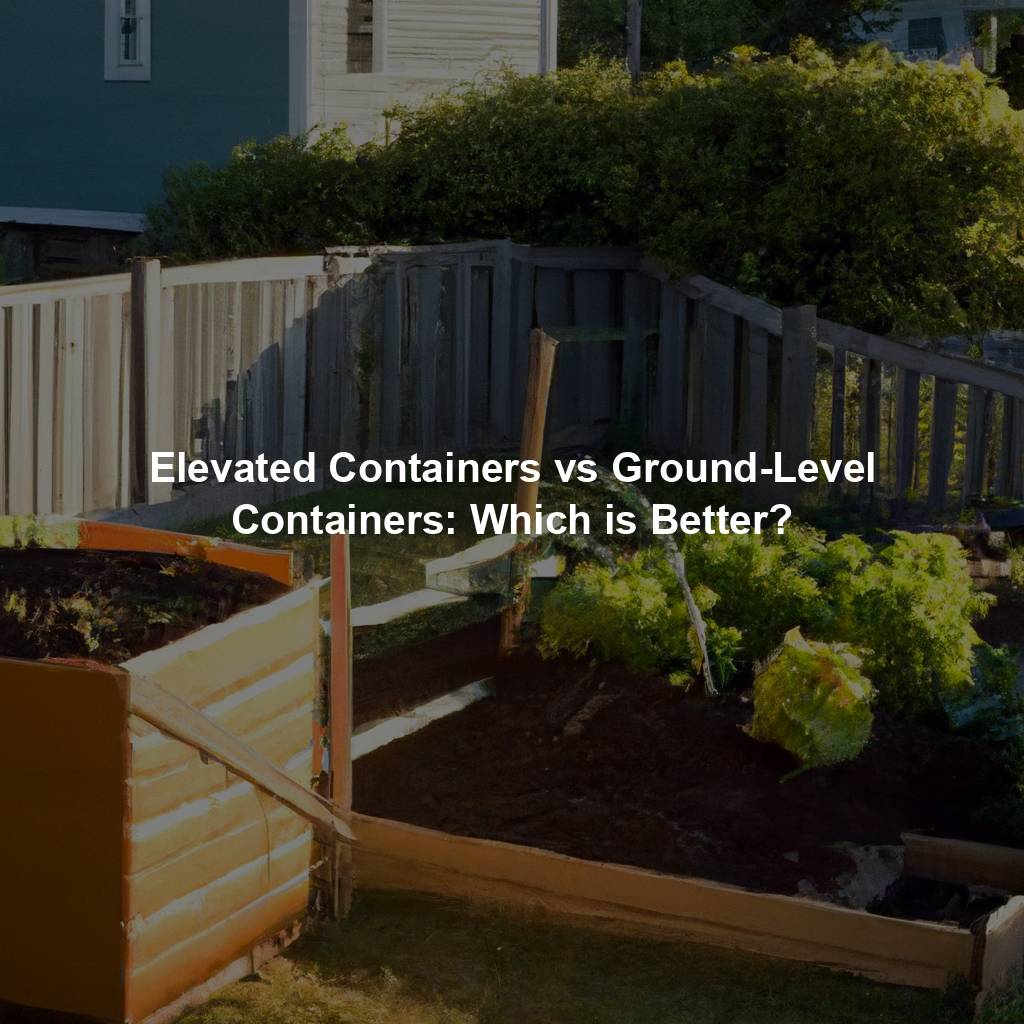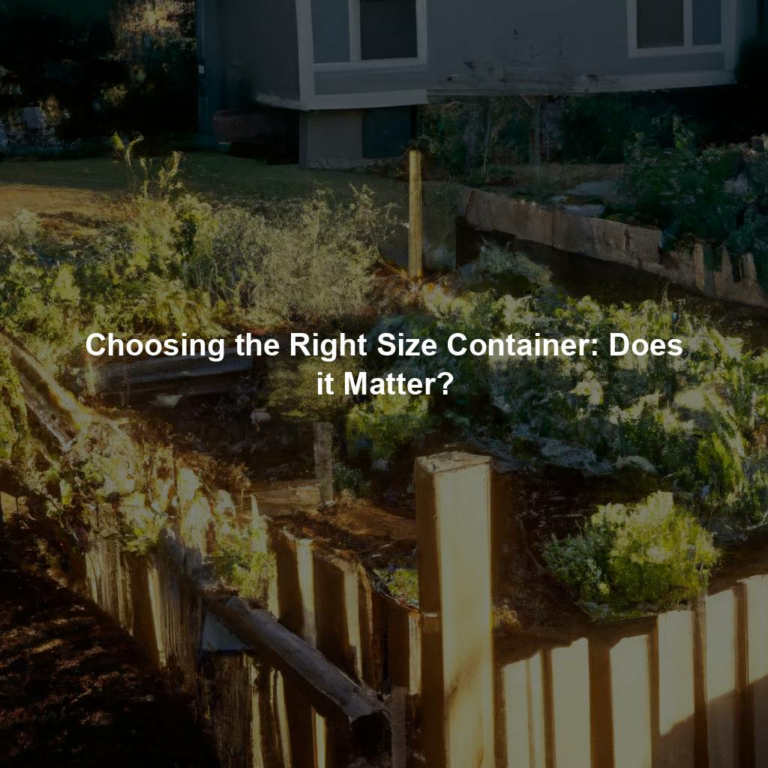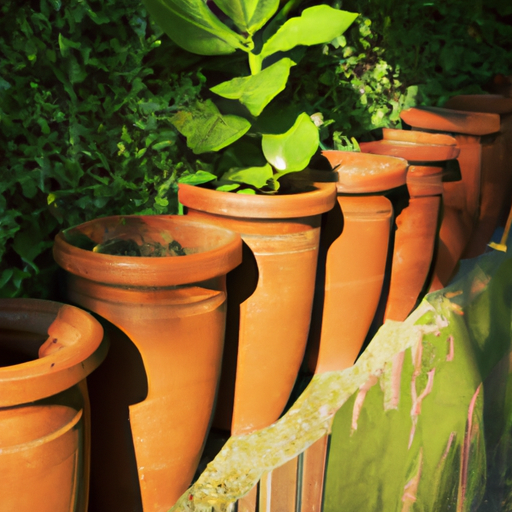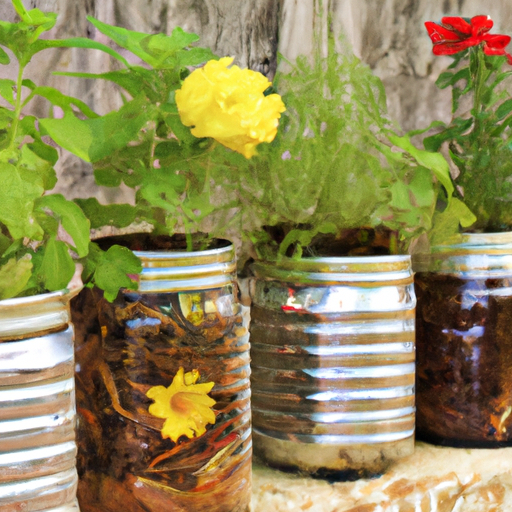Have you ever wondered whether it’s better to use elevated containers or ground-level containers for your plants? Well, wonder no more because we’re here to explore the pros and cons of each option.
Elevated containers, such as raised beds or hanging baskets, have become increasingly popular in recent years. They offer several benefits, including improved drainage and less strain on your back when planting and tending to them.
On the other hand, ground-level containers provide a natural growing environment that mimics traditional gardening methods while still allowing for easy accessibility.
So which is better? Let’s dig deeper into these two options and find out.
Advantages Of Elevated Containers
Picture yourself in a lush garden, surrounded by flourishing plants and beautiful flowers. Now imagine if you could take that experience to the next level – literally!
Elevated containers are an excellent way to elevate your gardening game, both figuratively and literally. Design features like trellises and tiered levels not only add aesthetic appeal but also provide more growing space for your beloved greenery.
Additionally, elevated containers offer improved accessibility and safety compared to their ground-level counterparts. No more bending down or kneeling on hard soil – with elevated containers, you can tend to your garden without straining your back or knees. Plus, they keep pesky critters away from your precious plants while offering better drainage and air circulation.
So why settle for ordinary when you can have extraordinary? Elevate your gardening experience with these practical yet stylish containers today!
Disadvantages Of Elevated Containers
When it comes to elevated containers, there are a few potential disadvantages that gardeners should consider. Structural stability is one concern as these types of containers can be more prone to tipping or becoming unbalanced if they are not properly secured or weighted down.
Additionally, accessibility challenges may arise when trying to care for plants in an elevated container, particularly for individuals with mobility issues who may struggle to reach the top of the container without assistance.
However, despite these drawbacks, many gardeners still prefer elevated containers due to their aesthetic appeal and ability to save space in smaller gardens or on balconies.
As with any gardening decision, it’s important to carefully weigh the pros and cons before deciding which type of container will work best for your specific needs and circumstances.
Advantages Of Ground-Level Containers
While elevated containers may have their disadvantages, ground-level containers offer several advantages that make them a great option for gardening.
One major advantage is the customization options available with ground-level containers. Since they are not raised off the ground, there are more possibilities when it comes to designing and building the container itself. This allows gardeners to create unique and personalized planters that fit their specific needs and style preferences.
Another benefit of using ground-level containers is cost effectiveness. Compared to elevated containers, which require additional materials such as supports or stands, ground-level containers can be made out of inexpensive materials like cinder blocks or wooden pallets. Additionally, these types of planters are often easier and less expensive to maintain since they don’t require special watering systems or other equipment.
Overall, while elevated containers may have some advantages, choosing a ground-level container offers greater flexibility in terms of personalization and affordability. By utilizing simple materials and customizable designs, gardeners can create beautiful and functional planters that will thrive for years to come.
Disadvantages Of Ground-Level Containers
When it comes to ground-level containers, there are several disadvantages that should be considered.
One of the main concerns is safety. Ground-level containers can be easily accessed by pets and small children, which could result in potential hazards such as accidental spills or ingestion of harmful substances.
Additionally, ground-level containers require more maintenance compared to elevated ones since they are exposed to moisture and pests like rodents and insects. This means that cleaning and pest control efforts must be increased, leading to higher maintenance costs over time.
It’s important to weigh these factors when deciding between elevated and ground-level containers for your gardening needs.
Choosing The Right Container For Your Needs
Just like how plants have different needs, gardeners also have varying preferences when it comes to containers. Some prefer elevated ones to save space and make watering easier while others choose ground-level containers for stability and accessibility.
But beyond personal preference, there are other factors to consider when choosing the right container for your needs. One of which is cost comparison – elevated containers can be more expensive due to their materials and specialized design while ground-level ones are generally cheaper since they don’t require additional support structures.
Another factor is sustainability concerns as elevated containers may not be environmentally friendly compared to repurposed ground-level options. As a Master Gardener, it’s important to weigh these considerations before making a decision that will impact both your plants and the planet.
So whether you choose an elevated or ground-level container, always remember that what matters most is finding one that meets your plant’s specific requirements and fits seamlessly into your gardening routine without compromising sustainability efforts.
Frequently Asked Questions
What Is The Maximum Height For An Elevated Container?
When it comes to elevated containers, one of the most important factors to consider is safety. While they can offer many benefits for gardening and landscaping projects, such as better drainage and improved accessibility, there are also inherent risks associated with working at height.
It’s essential to ensure that any elevated container is properly secured and stable before use, as well as taking precautions like using a ladder or harness if necessary. Additionally, it’s crucial to keep in mind the maximum height of an elevated container – while taller options may offer more space for larger plants or deeper soil layers, they could also pose greater danger if not built to withstand high winds or other weather conditions.
Ultimately, the decision between elevated containers and ground-level ones will depend on your specific needs and preferences – but by weighing these factors carefully, you can find the solution that works best for you.
How Does An Elevated Container Affect The Accessibility Of The Contents Inside?
When considering storage organization, container security is a top priority. That’s why it’s important to understand how elevated containers can affect the accessibility of their contents.
With an elevated container, you may need additional equipment or steps to access your items inside, which could be inconvenient for frequent use. However, this type of container offers added security from theft and weather damage because they are raised off the ground.
It ultimately depends on your specific needs and preferences when determining if an elevated container is right for storing your belongings.
Can Ground-Level Containers Be Converted Into Elevated Containers?
Ah, the age-old question of conversion feasibility! Can ground-level containers be transformed into elevated ones?
As a Master Gardener, I have seen many attempts at this feat. While it is technically possible to elevate your container garden with some DIY construction work, it may not always be cost-effective.
You must consider the materials needed for such a project and compare them to simply purchasing an already elevated container. Additionally, you will need to ensure that your converted container is structurally sound enough to support itself and its contents.
So, while it’s tempting to try and save a few bucks by converting your ground-level container, make sure you weigh the costs before diving in headfirst.
Are There Any Legal Restrictions On Using Elevated Containers In Certain Areas?
When it comes to using elevated containers, there are permit requirements and safety considerations that must be taken into account. Depending on the area, there may be specific regulations or restrictions in place regarding their use.
It’s important to do your research and consult with local authorities before installing an elevated container. Safety is also of utmost importance – you’ll want to ensure that the structure can support its weight capacity as well as withstand environmental factors such as wind or earthquakes.
With proper planning and precautions, however, elevated containers can provide unique benefits for storage or even living spaces.
How Do Ground-Level Containers Fare In Extreme Weather Conditions?
When it comes to extreme weather conditions, ground-level containers may present some durability concerns. These containers are closer to the ground and therefore more susceptible to damage from flooding or strong winds.
However, a cost effectiveness analysis should also be taken into consideration when choosing between elevated or ground-level containers. While elevating a container can provide added protection against severe weather, it may come with additional expenses for installation and maintenance.
It ultimately depends on the specific needs and budget of each individual or business owner.
Conclusion
Well folks, after all that research and contemplation, I have come to a conclusion on the great debate: elevated containers vs ground-level containers. And let me tell you, it’s quite an interesting topic.
First things first, if you’re looking for a container taller than Shaquille O’Neal, then elevated is the way to go. But beware, accessibility may become an issue unless you have arms like Inspector Gadget.
And as for converting ground-level containers into elevated ones? Let’s just say it’s easier to turn water into wine (although I wouldn’t recommend either without proper training).
But here’s where it gets juicy – legal restrictions. Who knew gardening could be so rebellious? Just make sure to check your local regulations before going rogue with your elevated container dreams.
As for extreme weather conditions, well Mother Nature can be unpredictable no matter what type of container you choose. So my advice? Buckle up and enjoy the ride (and maybe invest in some sturdy stakes).
In conclusion my fellow gardeners, whether you opt for elevated or ground-level containers depends on your personal preferences and needs. But don’t let anyone rain on your parade – if an elevated container speaks to your soul, go forth and conquer those height restrictions (just do it legally).
Happy planting!





